When looking at the occlusal view, there are other three important things that you need to look for:
- Margins
- Functional Cusp Bevel
- Occlusal Anatomy
Margins
When doing chamfer margins, you need to have at least 0.7mm-1mm reduction, shoulders on the other hand requires at least 1.2-1.5 or 1.5-2 for all ceramic crowns. These measurements are ideal measurements but could be modified depending on what the school will ask you to do. So unless the school releases some official guidelines for the dimensions, stick to these measurements that we taught to you:
Chamfer: 0.7mm, Shoulder: 1.2-1.5mm
These margins are designated for use depending on what type of material you are using for your crowns. Metals are resilient and tough even when it is thin. This property is fully optimized even when the material is at 0.7mm. That is why the reduction is kept at 0.7mm and it is unnecessary to go beyond until 1mm reduction. Remember that we need to at least preserve the tooth structure when we have the opportunity and necessity to do so.
Shoulders are designated for ceramic or ceramic with a metal substructure. Since we are talking about two materials here and ceramic is very brittle when thin, it requires a wider reduction to allow space to be made for a thicker material. Usually a 1.2mm reduction is enough for this matter.
When looking occlusally, the inner and outer line angles of the margins should be visually evident. Running through it with the tip of the explorer should have a nice squeaky feel with no bumps. One way of checking is to draw the outer and inner line angles with a pencil. If any of the lines are not clear or being obstructed in some way, it is more likely that the area has an undercut.
Insert video here
Functional Cusp Bevel
Functional Cusp bevel is an integral part of the occlusal reduction. Since this area deals with a lot of occlusal force, the functional cusp bevel creates an adequate space for the material to resist this force.
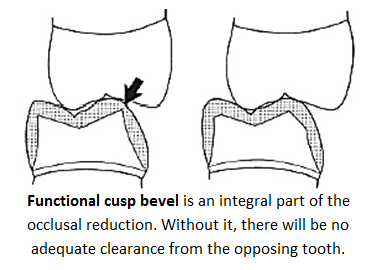
The functional cusp bevel goes hand in hand on how good your axial reduction is, so you have to take note of that. This video will explain you everything about the functional cusp bevel.
Insert video here
Occlusal Anatomy
Following the proper contour of the anatomy is very important because we want to create a uniform thickness of material on the occlusal portion.
Insert edited video here
Let’s review on the objective of occlusal reduction. The objectives of occlusal reduction is to create a uniform space interocclusally while maintaining the shape and location of the occlusal anatomy. Now we can only do this perfectly if we do depth grooves accurately. We need to place our depth grooves the same way as the direction of the grooves or the cusps that we want to maintain.\
Insert edited video here
Next is that some people would try to make the depth grooves as “defined” as possible especially when doing it on the central groove. They would go in deeper than the ideal. Now the problem with this is that your going to be leaving a slither of gouged area at the middle which is very unsightly. The main objective of placing a depth groove is that you want to connect both of the slopes and have them cleanly meet at the junction, looking as if it was like before it was reduced.
Insert edited video here
So two things to consider when making depth grooves: (1) accurate placement, (2) accurate depth.
However, there are some who are very faithful in preserving everything when in fact you have to first weigh in if what you are doing is correct or whether you do it just for the sake of doing it. Just for example when doing the occlusal reduction on a lower molar tooth, it is very unnecessary to maintain the distal cusp.
Insert edited video here
When placing depth grooves in this place and when you reduce the interproximals later on, It will eventually be gone. Saving it still will have a tendency to encroach the distobuccal cusp instead and will greatly interfere with the occlusal clearance. It is not worth it to conserve it, So just ignore it. It will not give you additional points when you save it anyway. This is one of the cases wherein you have to weigh in which of the features or principles are important. In this case, you are torn between saving the cusp or creating a good clearance. Well, the answer is simple, good clearance is much important. In the first place, the reason why we are preparing for crowns is to create space and clearance, right? So we could sacrifice the distal cusp to make way for other more important features.
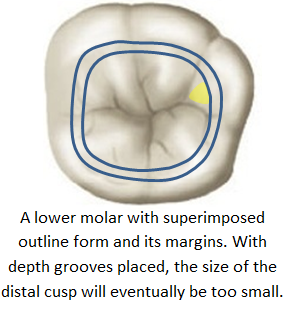
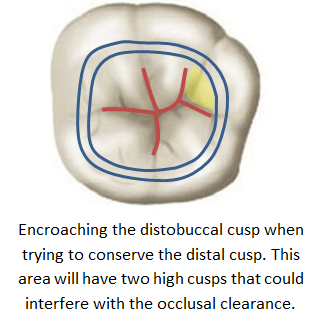
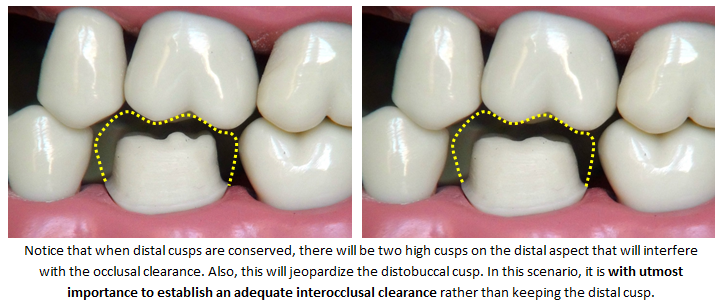
We go to the upper molars occlusal reduction, a common mistake is to shift the location of the Oblique Ridge. The problem behind this is that they place the depth groove directly on top of the oblique ridge. The result is that they will make the distolingual cusp bigger and will shift the oblique ridge more to the mesial. The correct way of placements is rather a little distal from the groove of the oblique ridge.
Insert video here


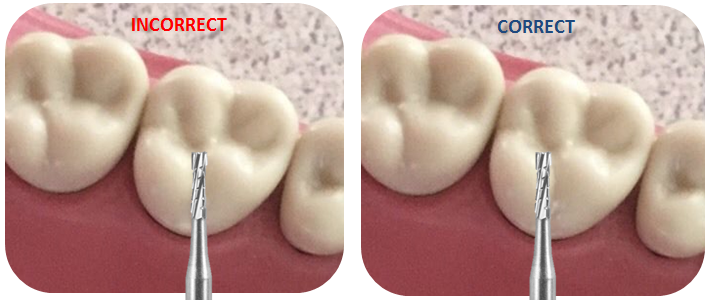
Last thing, make it a habit to run your fingers on the the cusps just to make sure that there will be no sharp points. Any sharp points are a potential stress points on the crown. You may use hand instruments or burs to smoothen these sharp areas.
